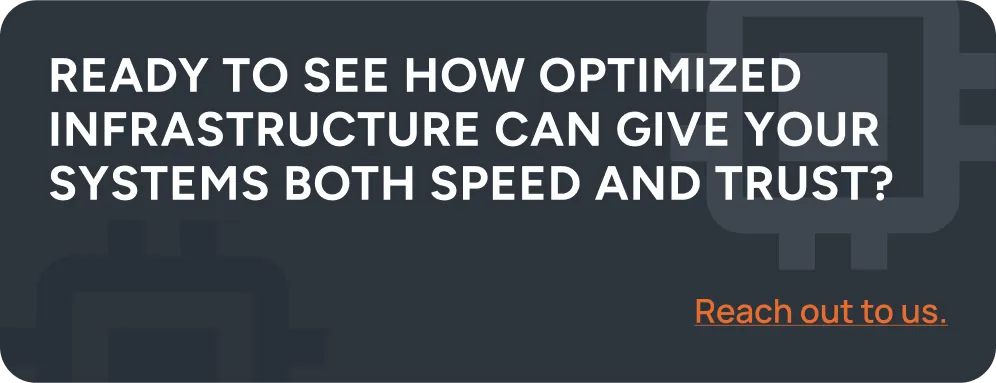AI is the invisible risk engine of financial services. It decides who gets approved, which transactions raise alarms, and how billions move across the globe. Where traders once relied on instinct and spreadsheets, today’s financial systems lean on algorithms that operate in microseconds. Fraud is intercepted before it drains an account. Credit decisions arrive while the application window is still open. Markets are scanned for signals faster than a banker can type.
But none of this intelligence runs on models alone. It runs on infrastructure: the networks, GPUs, storage systems, and governance layers behind the scenes that determine whether innovation scales securely or stalls under pressure.

Why fintech AI workloads push infrastructure to the limit
AI in finance isn’t just computationally heavy, it’s operationally unforgiving. Models have to process massive datasets, deliver results in real time, and do it all under strict regulatory oversight. A retail recommendation engine can afford a lag. A payment fraud system can’t.
Consider personalization: serving tailored offers requires analyzing thousands of data points about spending behavior instantly, across millions of customers. Or liquidity optimization: treasury teams depend on models that rebalance assets minute by minute to keep capital flowing. And layered on top of all of it is compliance: every output must be explainable, auditable, and secure.
These demands make infrastructure a strategic lever. How it’s designed determines not just model performance, but whether the business can operate at market speed and regulatory depth at the same time.
Inside the engine room: what powers fintech AI
Compute power: training models and running decisions at scale
AI workloads in finance are wide-ranging. They include training massive neural networks on historical transaction data and running real-time inference on live payments. Both require serious computing horsepower.
Example: A mid-size payments startup might deploy an 8–16 GPU cluster in the cloud to train fraud models. By year three, when they’re processing millions of daily transactions, their GPU demand rivals that of a global exchange’s risk systems.
Networking: keeping decisions in sync, at speed
In finance, lag can tip the balance between profit and loss. Payment approvals, order routing, and fraud alerts all rely on millisecond-level responses.
Without robust networking, a trading system can miss opportunities, or worse, expose the business to fraud because alerts arrive too late.
Storage: turning financial history into real-time insight
Financial AI applications juggle petabytes of data: payment histories, market feeds, customer records, call transcripts. Storage systems must deliver throughput, scale, and compliance in equal measure.
Example: A digital bank’s fraud models may need hot access to 90 days of transactions for training and inference, while storing 10 years of account data in lower-cost, compliant archives.
Software stack: orchestrating AI and enforcing compliance
The software layer determines how compute, storage, and networking work together. In FinTech, it must also enforce compliance and auditability.
Example: A wealth management app needs an architecture that can pull data from multiple exchanges, containerize microservices for portfolio analysis, and generate a complete audit trail for every recommendation.
Choosing where fintech AI runs: cloud, on-prem, or hybrid
Cloud for rapid iteration
Cloud is the starting point for many fintech startups. It lowers barriers and provides instant access to powerful GPUs. For teams still testing ideas, elasticity is invaluable.
Pitfall to avoid: Running sensitive financial data in non-compliant environments. Regulators won’t be forgiving.
Example: A payments startup uses cloud GPUs to retrain its fraud model weekly. As transaction volume grows, costs become harder to predict, prompting a shift to hybrid.
On-prem for control and predictability
For established institutions, on-premises infrastructure often becomes the backbone. Predictable workloads justify upfront capital.
Example: A credit bureau maintains an on-prem cluster to process loan applications within strict data residency requirements.
Hybrid for balancing trust and elasticity
Hybrid is gaining traction because it balances compliance with elasticity
Example: An insurer processes claims data on-prem but bursts to the cloud during a natural disaster, when claim volumes skyrocket.
Compliance and governance: why infrastructure must satisfy regulators
Finance data is among the most sensitive in the world. Infrastructure must satisfy a patchwork of global regulations.
Far from overhead, these safeguards are what make infrastructure credible to regulators, acceptable to auditors, and trustworthy to customers.
A roadmap for building resilient financial AI systems
An effective infrastructure plan begins with the workloads themselves: what models you need to run, how much data they handle, and how fast they must respond. To see how this translates in practice, let’s walk through the key steps a financial organization might take.
1. Define performance requirements
Every plan begins with performance. What models are you building: lightweight fraud classifiers or large-scale risk models? How much data do they consume, and do they need millisecond inference or can they run in-batch?
Scenario: A payments startup may need infrastructure that scans thousands of transactions per second for fraud. By contrast, a wealth management platform might emphasize depth of analysis over speed, prioritizing compute for complex forecasting models.
2. Factor in cost optimization
Hardware isn’t the only cost. Finance firms must weigh cloud vs. on-prem, calculate TCO, and use autoscaling to right-size resources. One common approach is to train models on premium GPU clusters, then run inference on lower-cost CPU-based systems.
Scenario: An online lender uses cloud GPUs for initial model training but shifts deployed credit-scoring models onto lighter infrastructure, keeping inference costs predictable.
3. Ensure security and compliance
Compliance isn’t optional. Encryption, audit trails, and access controls must be designed in from the start. Infrastructure has to meet standards like PCI DSS for payments, GDPR for personal data, and local banking regulations.
Scenario: A digital bank deploying a customer-support chatbot ensures not only fast responses but also encrypted storage, logged interactions, and audit-ready records for regulators.
4. Plan for reliability and redundancy
Infrastructure must provide redundancy, automated failover, and robust recovery systems to deliver near-continuous uptime.
Scenario: An automated trading system is distributed across multiple availability zones with failover mechanisms, aiming for 99.95%+ uptime to avoid costly interruptions.
5. Scale in phases
Finally, accept that infrastructure won’t stay static. Start lean, then expand as workloads mature and regulatory obligations grow.
What’s next: preparing for agentic AI in finance
AI in financial services is shifting from decision-support to decision-making. The next generation of systems won’t just recommend — they’ll act: approving loans, executing trades, adjusting portfolios, or blocking fraud in real time.
Enabling this evolution calls for more than raw compute:
The choices made today around infrastructure will shape whether agentic AI becomes a trusted force multiplier, or a regulatory flashpoint. Flexible, transparent systems will set the standard for the next era of autonomous finance.
Scaling fintech AI infrastructure at the speed of markets – with WhiteFiber
Financial AI workloads demand more than generic infrastructure. Trading systems need millisecond response, fraud detection requires nonstop throughput, and regulators expect complete transparency.
WhiteFiber’s platform delivers:
- Low-latency networking:
InfiniBand and ultra-fast Ethernet to keep transaction streams moving at speed. - AI-optimized storage:
High-throughput, tiered systems designed for both live workloads and compliant archiving. - Elastic scalability:
Seamless growth from pilot clusters to enterprise-grade deployments for trading, payments, and credit modeling. - Compliance by design:
Secure residency, immutable audit logs, and governance controls aligned with financial regulations. - Full observability:
End-to-end monitoring and orchestration to maximize utilization across training and inference.
With WhiteFiber, financial institutions gain infrastructure that combines speed, resilience, and regulatory readiness, built for the realities of modern markets.

FAQs: AI infrastructure for fintech
Why does AI in finance require specialized infrastructure?
Can financial institutions rely on cloud alone for AI?
What role does networking play in fintech AI?
How should financial data be stored for AI workloads?
How is compliance integrated into AI infrastructure?
What’s the biggest risk of underinvesting in infrastructure?
How can smaller fintech firms approach infrastructure without overbuilding?
What’s next for AI infrastructure in finance?


.webp)




.avif)
